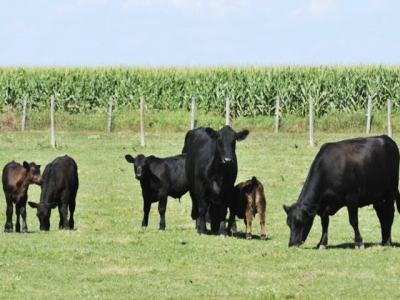Economist explores switching from dairy to beef

Years of tight profit margins and labor shortage led many Missouri dairies to switch to beef production.
Consolidation in the dairy industry led the University of Missouri Extension to help dairy producers switch to beef.
The dairy industry began consolidating after World War II as farms began to specialize in just milking cows, Extension agricultural economist Joe Horner said. The 1960s and 1970s saw more consolidation as fewer dairy farms made the expensive switch from selling milk in cans to bulk tanks.
Rapid consolidation continued over the last 10 years as dairies with more than 1,000 cows emerged. This lowered costs and put downward pressure on milk prices.
Years of tight profit margins and a shortage of labor led many Missouri dairies to switch to beef production. In fact, Horner noted that dairy operations have dropped by two-thirds in Missouri in the past 15 years. The story is repeated in almost every traditional dairy state, he added.
Missouri lost 27,000 dairy cows from 2009 to 2019 but added 67,000 beef cows over the same period.
Horner said there are important differences between dairy and beef operations. Beef cows require less labor, but it takes a lot more of them to make a living, Horner said.
Additionally, he said culling rates are different: 29.9% over five years for dairy compared to 13% for beef. Beef producers do not have to raise nearly as many heifers to keep the same herd size, Horner noted.
There are also seasonal differences between dairy and beef production as the dairy industry’s best prices come in the fall, while the worst are seen in the spring. Beef calves, on the other hand, fetch higher prices in the spring and lower prices in the fall, when spring calves go to market, Horner explained.
“Beef cow/calf operations typically sell cattle twice a year, but most of the wealth comes through land appreciation. Beef is a long-inning game. It is about holding onto land and keeping input costs low,” he said.
Horner urges dairy producers switching to beef to clean up their balance sheets, pay off bills and clear short-term debt by selling assets they no longer need. Additionally, he recommends working with an accountant to manage taxes during the sales.
“The switch to beef is a good way for dairy operators to use their livestock knowledge, skills and abilities built through a lifetime of milking cows,” Horner said, adding that it is also a good way to use existing resources as farmers approach retirement.
“Missouri is a huge producer of feeder calves. Dairy farmers who switch to beef have a natural fit for backgrounding those calves. They already have high-quality forage and feeding systems in place and are accustomed to managing lots of dollars,” he explained.
The good news is that beef cows do not need to be milked every morning and night, so it is easier to get away from the farm for a few days.
Có thể bạn quan tâm
Phần mềm

Phối trộn thức ăn chăn nuôi

Pha dung dịch thủy canh

Định mức cho tôm ăn

Phối trộn phân bón NPK

Xác định tỷ lệ tôm sống

Chuyển đổi đơn vị phân bón

Xác định công suất sục khí

Chuyển đổi đơn vị tôm

Tính diện tích nhà kính

Tính thể tích ao hồ



 International partners to study endocannabinoid system in dairy…
International partners to study endocannabinoid system in dairy…  Dutch dairy consortium evaluating effectiveness of DSM methane…
Dutch dairy consortium evaluating effectiveness of DSM methane…